Business Model Development: Coffee Shop Idea in Perth, Australia
VerifiedAdded on 2022/10/11
|14
|2825
|12
Report
AI Summary
This report presents a comprehensive business plan for a new coffee shop in Perth, Australia. It begins with an introduction emphasizing the importance of market research and understanding industry dynamics before launching a new business. The report utilizes the Business Model Canvas to outline key aspects, including key partners, activities, value propositions, customer relationships, customer segments, key resources, channels, cost structure, and revenue streams. It then identifies market and customer problems, such as the competitive landscape of existing coffee shops in Perth, and the challenges of brand and customer loyalty. The report proposes solutions to these problems, including optimized coffee mug sizes, pricing strategies that involve offers and discounts, and fostering customer loyalty. It also details the benefits to customers, success factors, critical risks, and assumptions, and evaluates the feasibility of the business idea. The report concludes with a summary of the key findings and references supporting literature. The appendix includes the detailed Business Model Canvas.
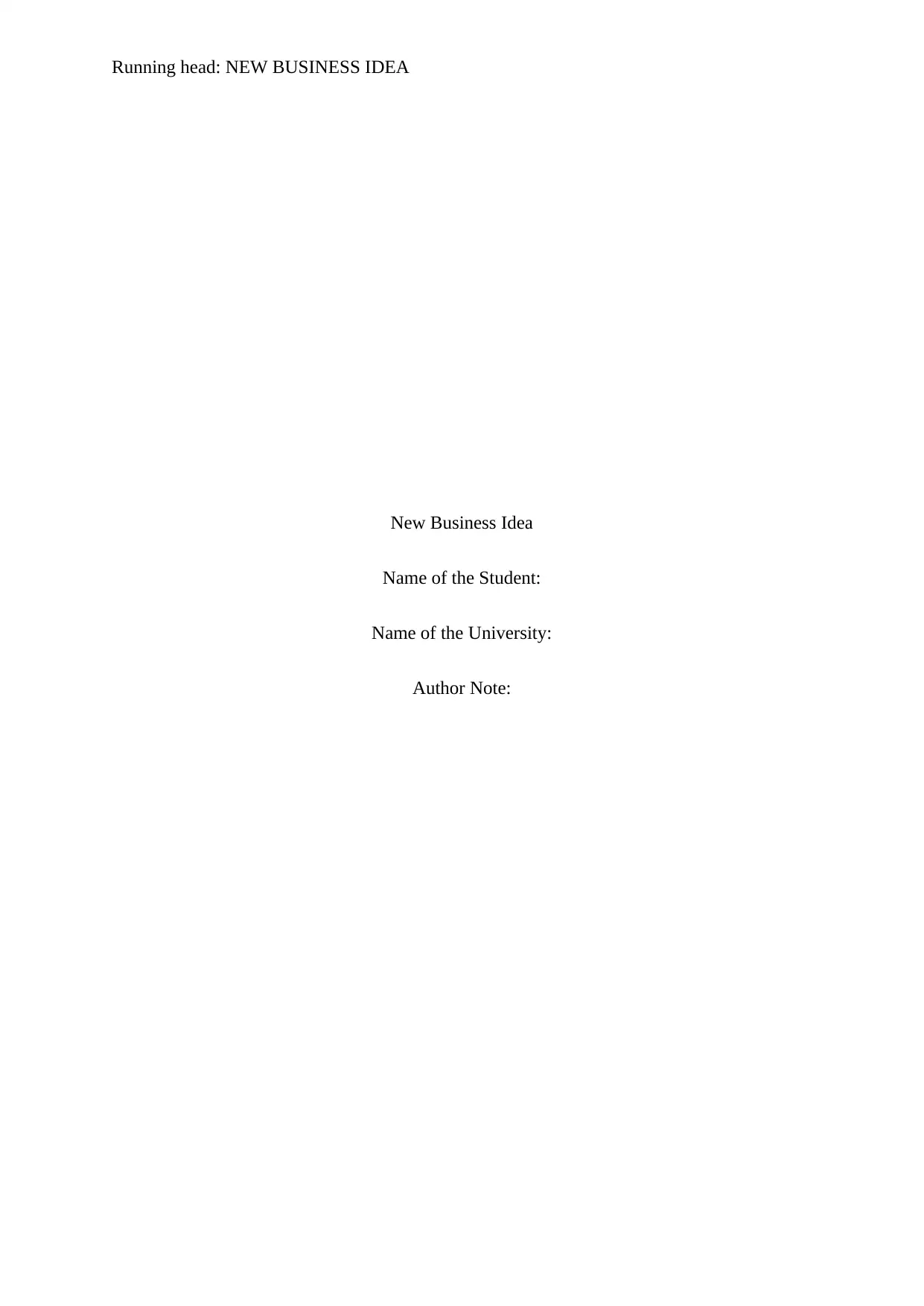
Running head: NEW BUSINESS IDEA
New Business Idea
Name of the Student:
Name of the University:
Author Note:
New Business Idea
Name of the Student:
Name of the University:
Author Note:
Paraphrase This Document
Need a fresh take? Get an instant paraphrase of this document with our AI Paraphraser
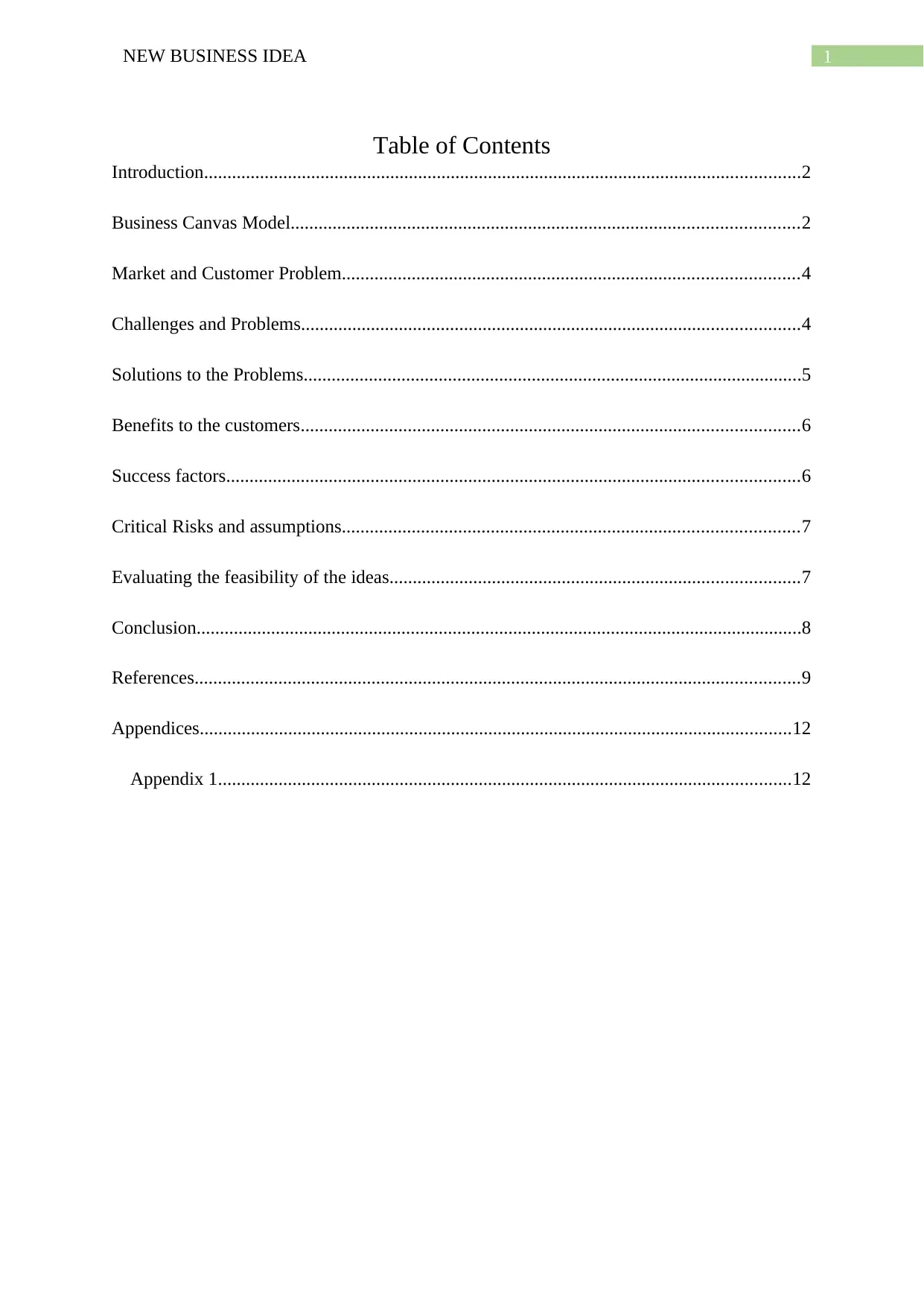
1NEW BUSINESS IDEA
Table of Contents
Introduction................................................................................................................................2
Business Canvas Model.............................................................................................................2
Market and Customer Problem..................................................................................................4
Challenges and Problems...........................................................................................................4
Solutions to the Problems...........................................................................................................5
Benefits to the customers...........................................................................................................6
Success factors...........................................................................................................................6
Critical Risks and assumptions..................................................................................................7
Evaluating the feasibility of the ideas........................................................................................7
Conclusion..................................................................................................................................8
References..................................................................................................................................9
Appendices...............................................................................................................................12
Appendix 1...........................................................................................................................12
Table of Contents
Introduction................................................................................................................................2
Business Canvas Model.............................................................................................................2
Market and Customer Problem..................................................................................................4
Challenges and Problems...........................................................................................................4
Solutions to the Problems...........................................................................................................5
Benefits to the customers...........................................................................................................6
Success factors...........................................................................................................................6
Critical Risks and assumptions..................................................................................................7
Evaluating the feasibility of the ideas........................................................................................7
Conclusion..................................................................................................................................8
References..................................................................................................................................9
Appendices...............................................................................................................................12
Appendix 1...........................................................................................................................12
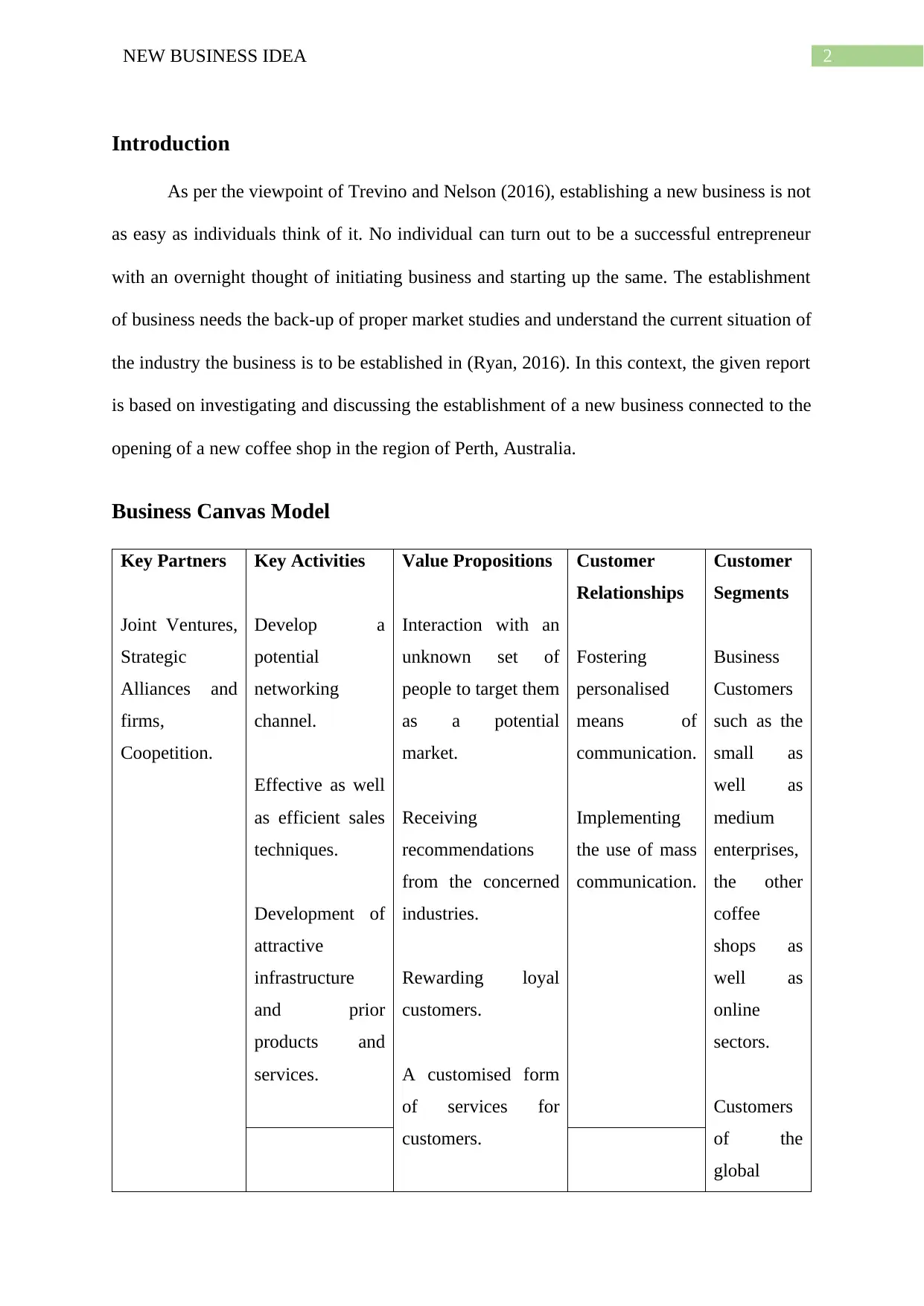
2NEW BUSINESS IDEA
Introduction
As per the viewpoint of Trevino and Nelson (2016), establishing a new business is not
as easy as individuals think of it. No individual can turn out to be a successful entrepreneur
with an overnight thought of initiating business and starting up the same. The establishment
of business needs the back-up of proper market studies and understand the current situation of
the industry the business is to be established in (Ryan, 2016). In this context, the given report
is based on investigating and discussing the establishment of a new business connected to the
opening of a new coffee shop in the region of Perth, Australia.
Business Canvas Model
Key Partners
Joint Ventures,
Strategic
Alliances and
firms,
Coopetition.
Key Activities
Develop a
potential
networking
channel.
Effective as well
as efficient sales
techniques.
Development of
attractive
infrastructure
and prior
products and
services.
Value Propositions
Interaction with an
unknown set of
people to target them
as a potential
market.
Receiving
recommendations
from the concerned
industries.
Rewarding loyal
customers.
A customised form
of services for
customers.
Customer
Relationships
Fostering
personalised
means of
communication.
Implementing
the use of mass
communication.
Customer
Segments
Business
Customers
such as the
small as
well as
medium
enterprises,
the other
coffee
shops as
well as
online
sectors.
Customers
of the
global
Introduction
As per the viewpoint of Trevino and Nelson (2016), establishing a new business is not
as easy as individuals think of it. No individual can turn out to be a successful entrepreneur
with an overnight thought of initiating business and starting up the same. The establishment
of business needs the back-up of proper market studies and understand the current situation of
the industry the business is to be established in (Ryan, 2016). In this context, the given report
is based on investigating and discussing the establishment of a new business connected to the
opening of a new coffee shop in the region of Perth, Australia.
Business Canvas Model
Key Partners
Joint Ventures,
Strategic
Alliances and
firms,
Coopetition.
Key Activities
Develop a
potential
networking
channel.
Effective as well
as efficient sales
techniques.
Development of
attractive
infrastructure
and prior
products and
services.
Value Propositions
Interaction with an
unknown set of
people to target them
as a potential
market.
Receiving
recommendations
from the concerned
industries.
Rewarding loyal
customers.
A customised form
of services for
customers.
Customer
Relationships
Fostering
personalised
means of
communication.
Implementing
the use of mass
communication.
Customer
Segments
Business
Customers
such as the
small as
well as
medium
enterprises,
the other
coffee
shops as
well as
online
sectors.
Customers
of the
global
⊘ This is a preview!⊘
Do you want full access?
Subscribe today to unlock all pages.

Trusted by 1+ million students worldwide
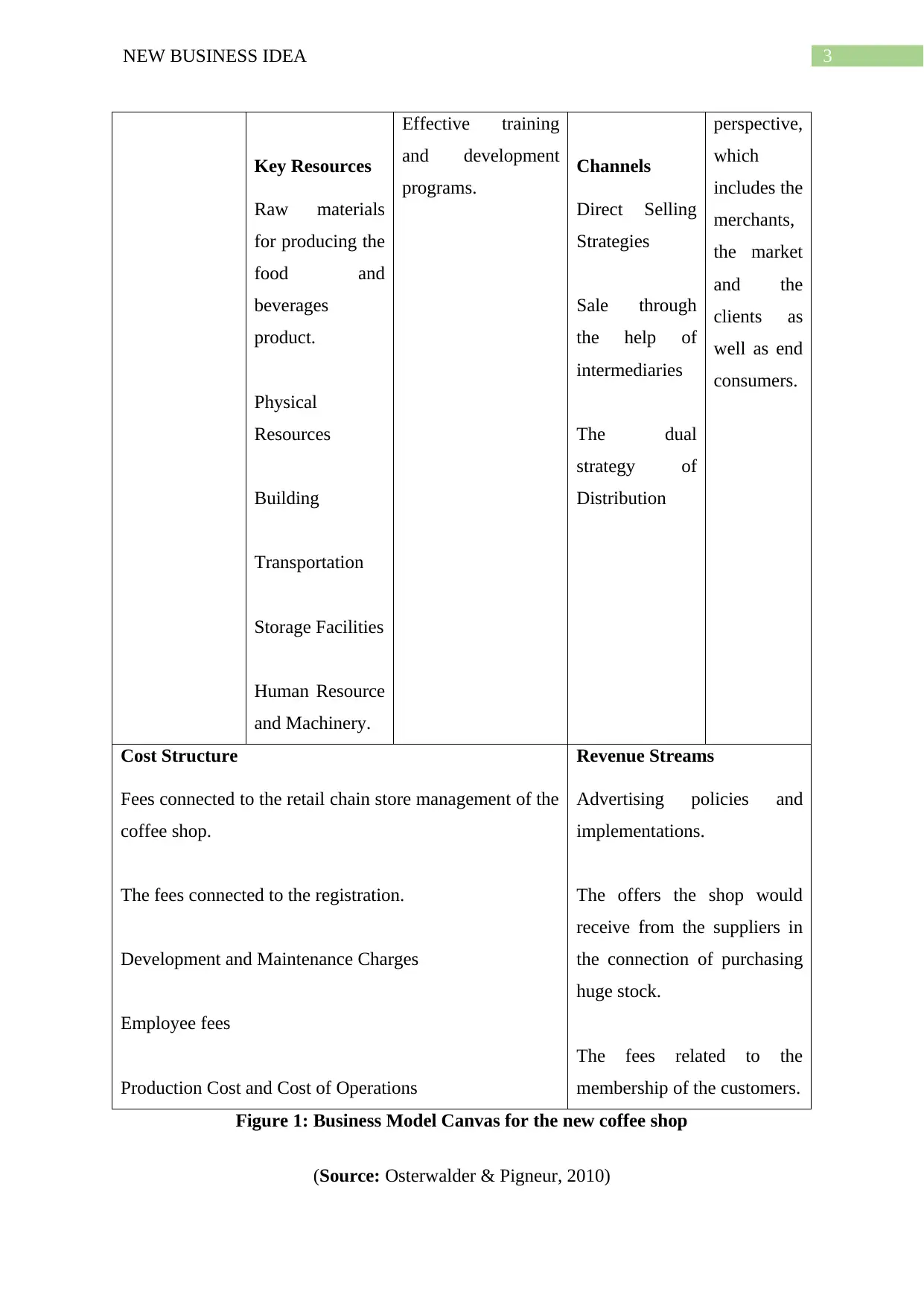
3NEW BUSINESS IDEA
Key Resources
Raw materials
for producing the
food and
beverages
product.
Physical
Resources
Building
Transportation
Storage Facilities
Human Resource
and Machinery.
Effective training
and development
programs.
Channels
Direct Selling
Strategies
Sale through
the help of
intermediaries
The dual
strategy of
Distribution
perspective,
which
includes the
merchants,
the market
and the
clients as
well as end
consumers.
Cost Structure
Fees connected to the retail chain store management of the
coffee shop.
The fees connected to the registration.
Development and Maintenance Charges
Employee fees
Production Cost and Cost of Operations
Revenue Streams
Advertising policies and
implementations.
The offers the shop would
receive from the suppliers in
the connection of purchasing
huge stock.
The fees related to the
membership of the customers.
Figure 1: Business Model Canvas for the new coffee shop
(Source: Osterwalder & Pigneur, 2010)
Key Resources
Raw materials
for producing the
food and
beverages
product.
Physical
Resources
Building
Transportation
Storage Facilities
Human Resource
and Machinery.
Effective training
and development
programs.
Channels
Direct Selling
Strategies
Sale through
the help of
intermediaries
The dual
strategy of
Distribution
perspective,
which
includes the
merchants,
the market
and the
clients as
well as end
consumers.
Cost Structure
Fees connected to the retail chain store management of the
coffee shop.
The fees connected to the registration.
Development and Maintenance Charges
Employee fees
Production Cost and Cost of Operations
Revenue Streams
Advertising policies and
implementations.
The offers the shop would
receive from the suppliers in
the connection of purchasing
huge stock.
The fees related to the
membership of the customers.
Figure 1: Business Model Canvas for the new coffee shop
(Source: Osterwalder & Pigneur, 2010)
Paraphrase This Document
Need a fresh take? Get an instant paraphrase of this document with our AI Paraphraser
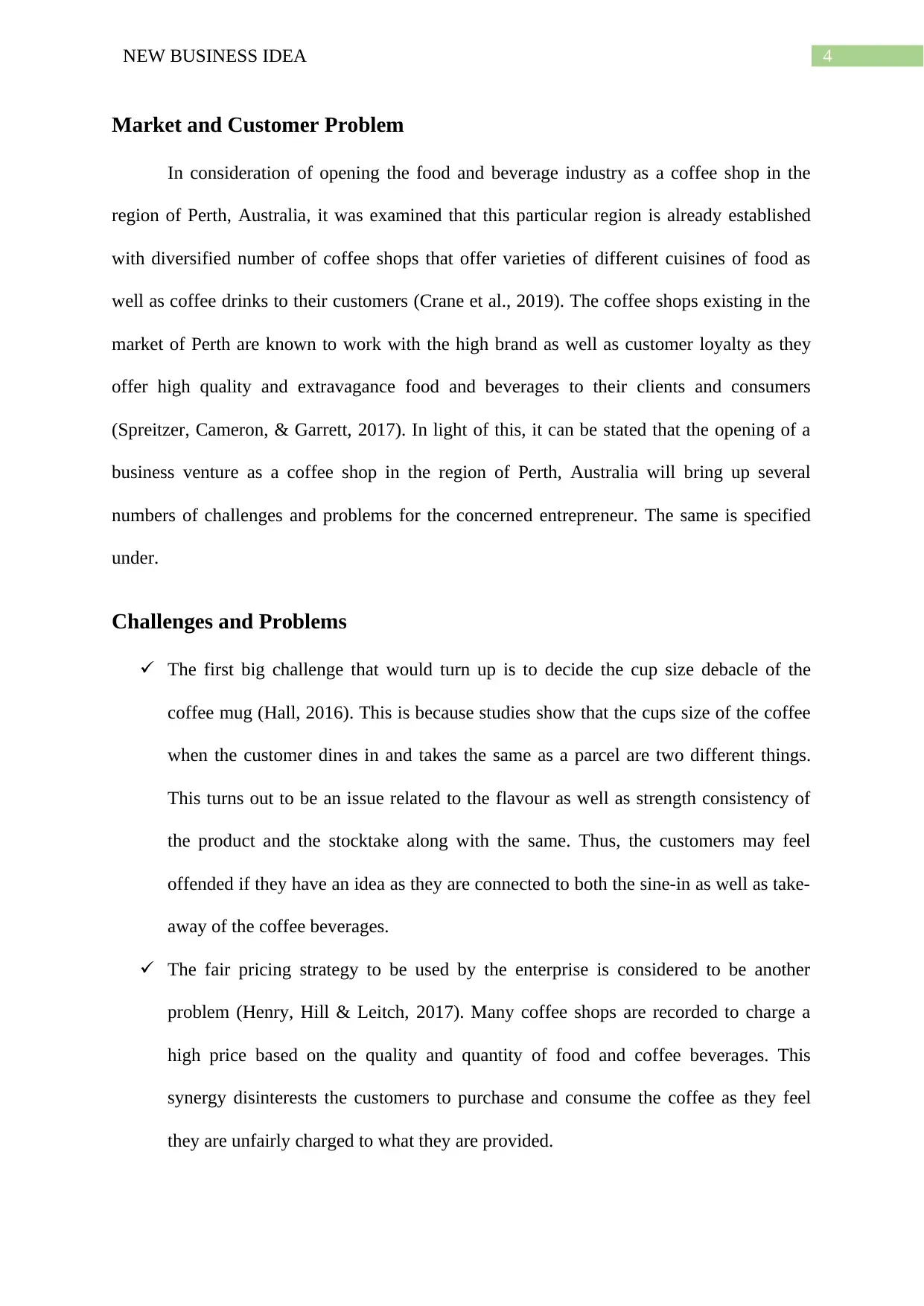
4NEW BUSINESS IDEA
Market and Customer Problem
In consideration of opening the food and beverage industry as a coffee shop in the
region of Perth, Australia, it was examined that this particular region is already established
with diversified number of coffee shops that offer varieties of different cuisines of food as
well as coffee drinks to their customers (Crane et al., 2019). The coffee shops existing in the
market of Perth are known to work with the high brand as well as customer loyalty as they
offer high quality and extravagance food and beverages to their clients and consumers
(Spreitzer, Cameron, & Garrett, 2017). In light of this, it can be stated that the opening of a
business venture as a coffee shop in the region of Perth, Australia will bring up several
numbers of challenges and problems for the concerned entrepreneur. The same is specified
under.
Challenges and Problems
The first big challenge that would turn up is to decide the cup size debacle of the
coffee mug (Hall, 2016). This is because studies show that the cups size of the coffee
when the customer dines in and takes the same as a parcel are two different things.
This turns out to be an issue related to the flavour as well as strength consistency of
the product and the stocktake along with the same. Thus, the customers may feel
offended if they have an idea as they are connected to both the sine-in as well as take-
away of the coffee beverages.
The fair pricing strategy to be used by the enterprise is considered to be another
problem (Henry, Hill & Leitch, 2017). Many coffee shops are recorded to charge a
high price based on the quality and quantity of food and coffee beverages. This
synergy disinterests the customers to purchase and consume the coffee as they feel
they are unfairly charged to what they are provided.
Market and Customer Problem
In consideration of opening the food and beverage industry as a coffee shop in the
region of Perth, Australia, it was examined that this particular region is already established
with diversified number of coffee shops that offer varieties of different cuisines of food as
well as coffee drinks to their customers (Crane et al., 2019). The coffee shops existing in the
market of Perth are known to work with the high brand as well as customer loyalty as they
offer high quality and extravagance food and beverages to their clients and consumers
(Spreitzer, Cameron, & Garrett, 2017). In light of this, it can be stated that the opening of a
business venture as a coffee shop in the region of Perth, Australia will bring up several
numbers of challenges and problems for the concerned entrepreneur. The same is specified
under.
Challenges and Problems
The first big challenge that would turn up is to decide the cup size debacle of the
coffee mug (Hall, 2016). This is because studies show that the cups size of the coffee
when the customer dines in and takes the same as a parcel are two different things.
This turns out to be an issue related to the flavour as well as strength consistency of
the product and the stocktake along with the same. Thus, the customers may feel
offended if they have an idea as they are connected to both the sine-in as well as take-
away of the coffee beverages.
The fair pricing strategy to be used by the enterprise is considered to be another
problem (Henry, Hill & Leitch, 2017). Many coffee shops are recorded to charge a
high price based on the quality and quantity of food and coffee beverages. This
synergy disinterests the customers to purchase and consume the coffee as they feel
they are unfairly charged to what they are provided.
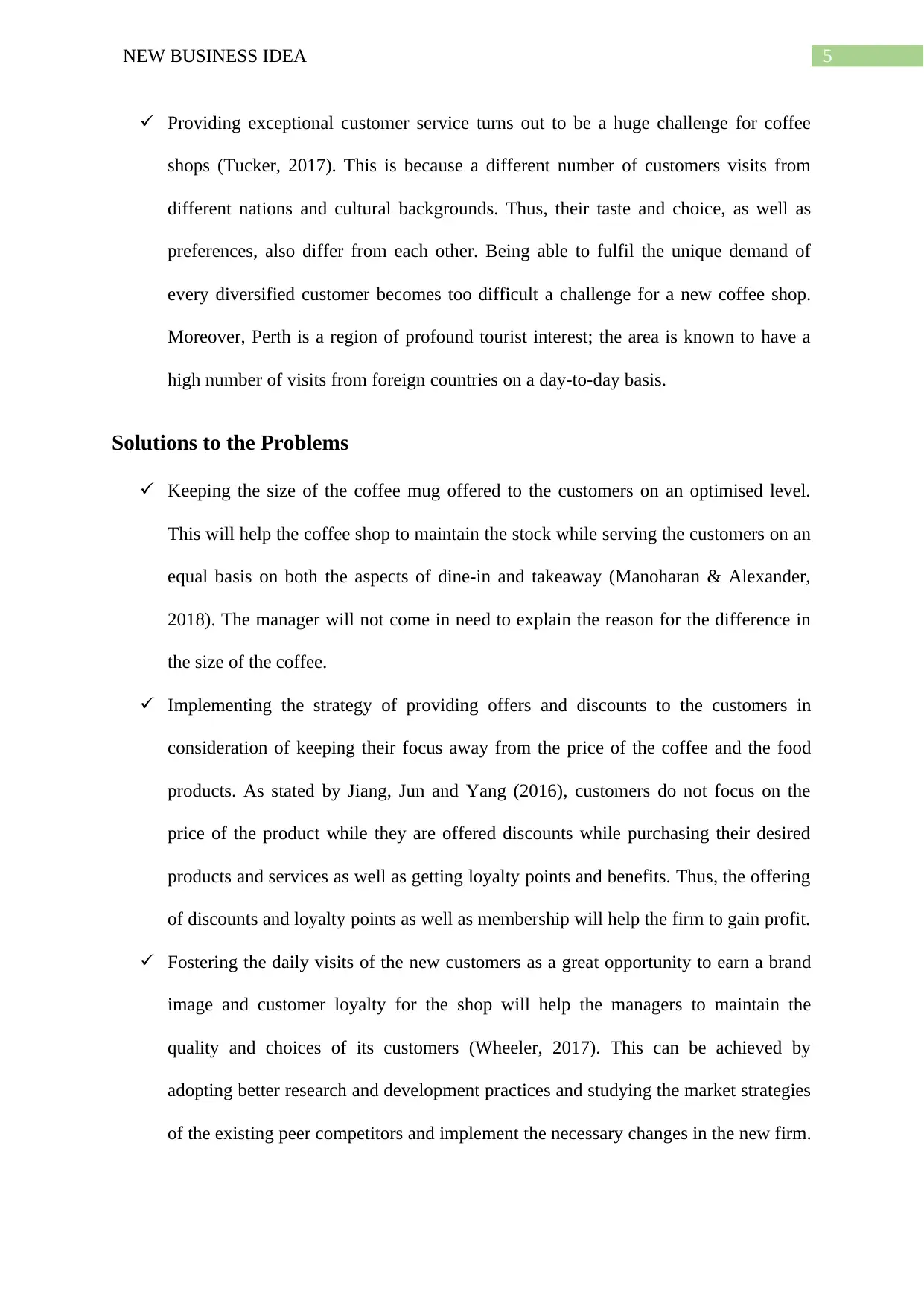
5NEW BUSINESS IDEA
Providing exceptional customer service turns out to be a huge challenge for coffee
shops (Tucker, 2017). This is because a different number of customers visits from
different nations and cultural backgrounds. Thus, their taste and choice, as well as
preferences, also differ from each other. Being able to fulfil the unique demand of
every diversified customer becomes too difficult a challenge for a new coffee shop.
Moreover, Perth is a region of profound tourist interest; the area is known to have a
high number of visits from foreign countries on a day-to-day basis.
Solutions to the Problems
Keeping the size of the coffee mug offered to the customers on an optimised level.
This will help the coffee shop to maintain the stock while serving the customers on an
equal basis on both the aspects of dine-in and takeaway (Manoharan & Alexander,
2018). The manager will not come in need to explain the reason for the difference in
the size of the coffee.
Implementing the strategy of providing offers and discounts to the customers in
consideration of keeping their focus away from the price of the coffee and the food
products. As stated by Jiang, Jun and Yang (2016), customers do not focus on the
price of the product while they are offered discounts while purchasing their desired
products and services as well as getting loyalty points and benefits. Thus, the offering
of discounts and loyalty points as well as membership will help the firm to gain profit.
Fostering the daily visits of the new customers as a great opportunity to earn a brand
image and customer loyalty for the shop will help the managers to maintain the
quality and choices of its customers (Wheeler, 2017). This can be achieved by
adopting better research and development practices and studying the market strategies
of the existing peer competitors and implement the necessary changes in the new firm.
Providing exceptional customer service turns out to be a huge challenge for coffee
shops (Tucker, 2017). This is because a different number of customers visits from
different nations and cultural backgrounds. Thus, their taste and choice, as well as
preferences, also differ from each other. Being able to fulfil the unique demand of
every diversified customer becomes too difficult a challenge for a new coffee shop.
Moreover, Perth is a region of profound tourist interest; the area is known to have a
high number of visits from foreign countries on a day-to-day basis.
Solutions to the Problems
Keeping the size of the coffee mug offered to the customers on an optimised level.
This will help the coffee shop to maintain the stock while serving the customers on an
equal basis on both the aspects of dine-in and takeaway (Manoharan & Alexander,
2018). The manager will not come in need to explain the reason for the difference in
the size of the coffee.
Implementing the strategy of providing offers and discounts to the customers in
consideration of keeping their focus away from the price of the coffee and the food
products. As stated by Jiang, Jun and Yang (2016), customers do not focus on the
price of the product while they are offered discounts while purchasing their desired
products and services as well as getting loyalty points and benefits. Thus, the offering
of discounts and loyalty points as well as membership will help the firm to gain profit.
Fostering the daily visits of the new customers as a great opportunity to earn a brand
image and customer loyalty for the shop will help the managers to maintain the
quality and choices of its customers (Wheeler, 2017). This can be achieved by
adopting better research and development practices and studying the market strategies
of the existing peer competitors and implement the necessary changes in the new firm.
⊘ This is a preview!⊘
Do you want full access?
Subscribe today to unlock all pages.

Trusted by 1+ million students worldwide
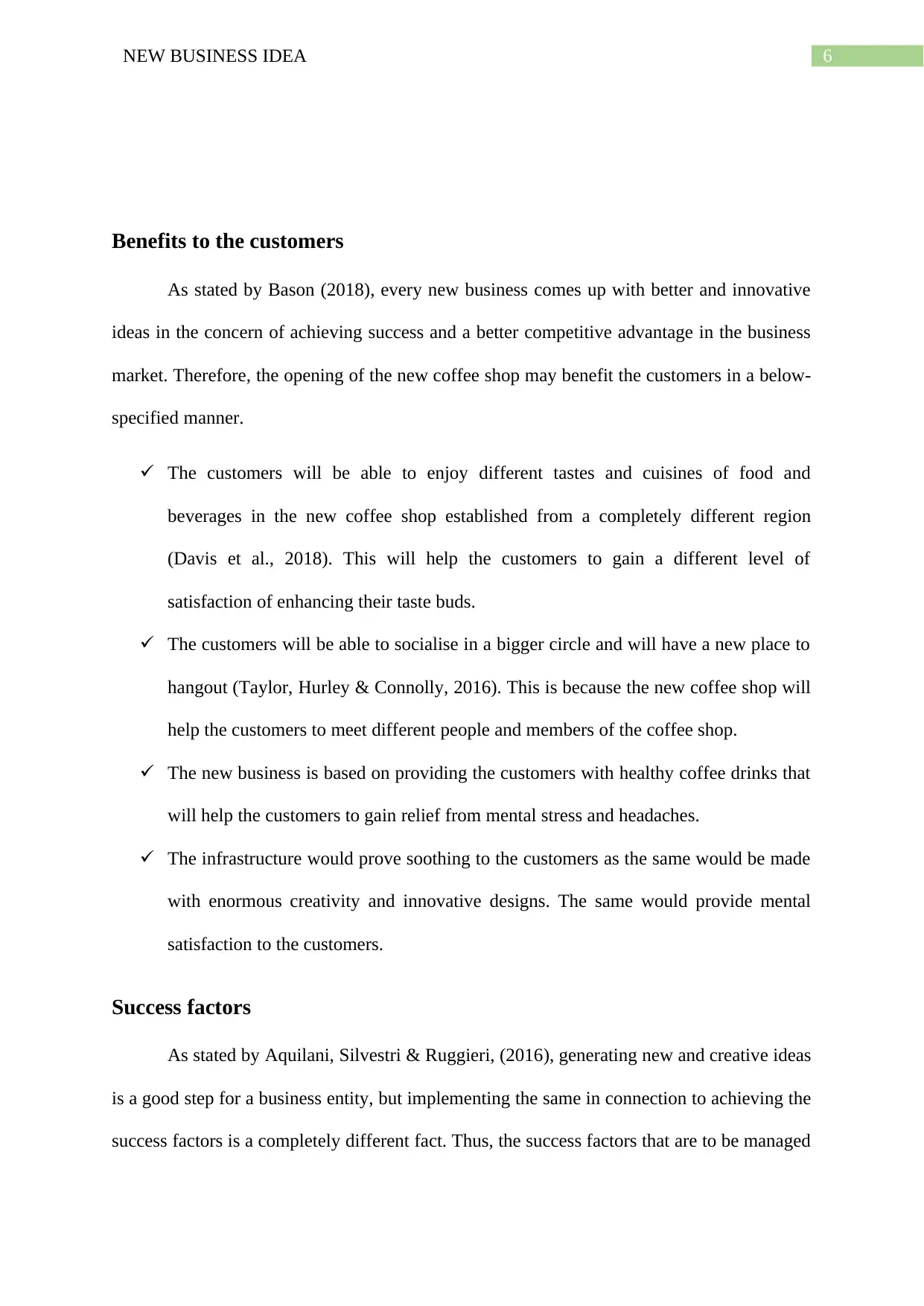
6NEW BUSINESS IDEA
Benefits to the customers
As stated by Bason (2018), every new business comes up with better and innovative
ideas in the concern of achieving success and a better competitive advantage in the business
market. Therefore, the opening of the new coffee shop may benefit the customers in a below-
specified manner.
The customers will be able to enjoy different tastes and cuisines of food and
beverages in the new coffee shop established from a completely different region
(Davis et al., 2018). This will help the customers to gain a different level of
satisfaction of enhancing their taste buds.
The customers will be able to socialise in a bigger circle and will have a new place to
hangout (Taylor, Hurley & Connolly, 2016). This is because the new coffee shop will
help the customers to meet different people and members of the coffee shop.
The new business is based on providing the customers with healthy coffee drinks that
will help the customers to gain relief from mental stress and headaches.
The infrastructure would prove soothing to the customers as the same would be made
with enormous creativity and innovative designs. The same would provide mental
satisfaction to the customers.
Success factors
As stated by Aquilani, Silvestri & Ruggieri, (2016), generating new and creative ideas
is a good step for a business entity, but implementing the same in connection to achieving the
success factors is a completely different fact. Thus, the success factors that are to be managed
Benefits to the customers
As stated by Bason (2018), every new business comes up with better and innovative
ideas in the concern of achieving success and a better competitive advantage in the business
market. Therefore, the opening of the new coffee shop may benefit the customers in a below-
specified manner.
The customers will be able to enjoy different tastes and cuisines of food and
beverages in the new coffee shop established from a completely different region
(Davis et al., 2018). This will help the customers to gain a different level of
satisfaction of enhancing their taste buds.
The customers will be able to socialise in a bigger circle and will have a new place to
hangout (Taylor, Hurley & Connolly, 2016). This is because the new coffee shop will
help the customers to meet different people and members of the coffee shop.
The new business is based on providing the customers with healthy coffee drinks that
will help the customers to gain relief from mental stress and headaches.
The infrastructure would prove soothing to the customers as the same would be made
with enormous creativity and innovative designs. The same would provide mental
satisfaction to the customers.
Success factors
As stated by Aquilani, Silvestri & Ruggieri, (2016), generating new and creative ideas
is a good step for a business entity, but implementing the same in connection to achieving the
success factors is a completely different fact. Thus, the success factors that are to be managed
Paraphrase This Document
Need a fresh take? Get an instant paraphrase of this document with our AI Paraphraser
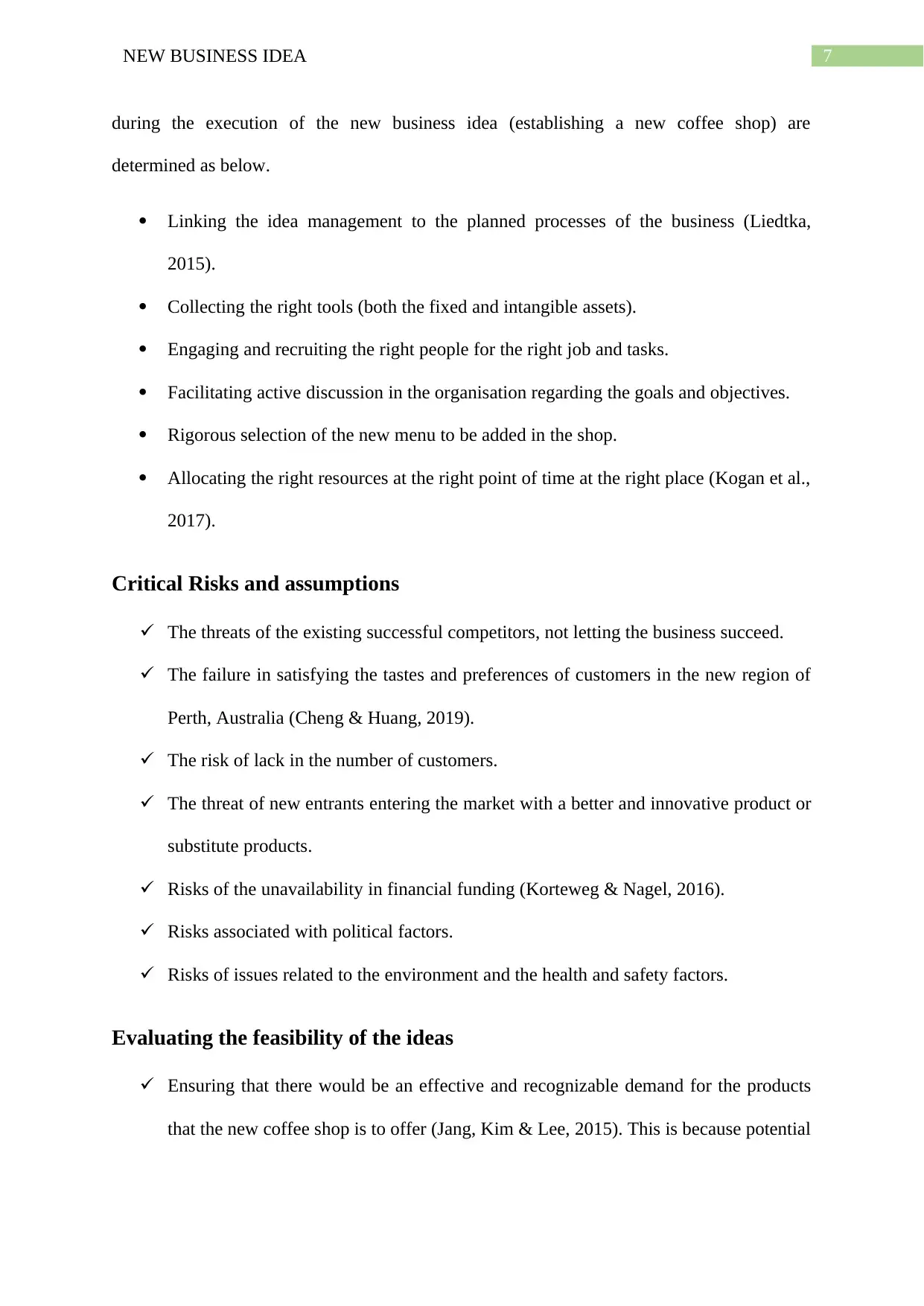
7NEW BUSINESS IDEA
during the execution of the new business idea (establishing a new coffee shop) are
determined as below.
Linking the idea management to the planned processes of the business (Liedtka,
2015).
Collecting the right tools (both the fixed and intangible assets).
Engaging and recruiting the right people for the right job and tasks.
Facilitating active discussion in the organisation regarding the goals and objectives.
Rigorous selection of the new menu to be added in the shop.
Allocating the right resources at the right point of time at the right place (Kogan et al.,
2017).
Critical Risks and assumptions
The threats of the existing successful competitors, not letting the business succeed.
The failure in satisfying the tastes and preferences of customers in the new region of
Perth, Australia (Cheng & Huang, 2019).
The risk of lack in the number of customers.
The threat of new entrants entering the market with a better and innovative product or
substitute products.
Risks of the unavailability in financial funding (Korteweg & Nagel, 2016).
Risks associated with political factors.
Risks of issues related to the environment and the health and safety factors.
Evaluating the feasibility of the ideas
Ensuring that there would be an effective and recognizable demand for the products
that the new coffee shop is to offer (Jang, Kim & Lee, 2015). This is because potential
during the execution of the new business idea (establishing a new coffee shop) are
determined as below.
Linking the idea management to the planned processes of the business (Liedtka,
2015).
Collecting the right tools (both the fixed and intangible assets).
Engaging and recruiting the right people for the right job and tasks.
Facilitating active discussion in the organisation regarding the goals and objectives.
Rigorous selection of the new menu to be added in the shop.
Allocating the right resources at the right point of time at the right place (Kogan et al.,
2017).
Critical Risks and assumptions
The threats of the existing successful competitors, not letting the business succeed.
The failure in satisfying the tastes and preferences of customers in the new region of
Perth, Australia (Cheng & Huang, 2019).
The risk of lack in the number of customers.
The threat of new entrants entering the market with a better and innovative product or
substitute products.
Risks of the unavailability in financial funding (Korteweg & Nagel, 2016).
Risks associated with political factors.
Risks of issues related to the environment and the health and safety factors.
Evaluating the feasibility of the ideas
Ensuring that there would be an effective and recognizable demand for the products
that the new coffee shop is to offer (Jang, Kim & Lee, 2015). This is because potential
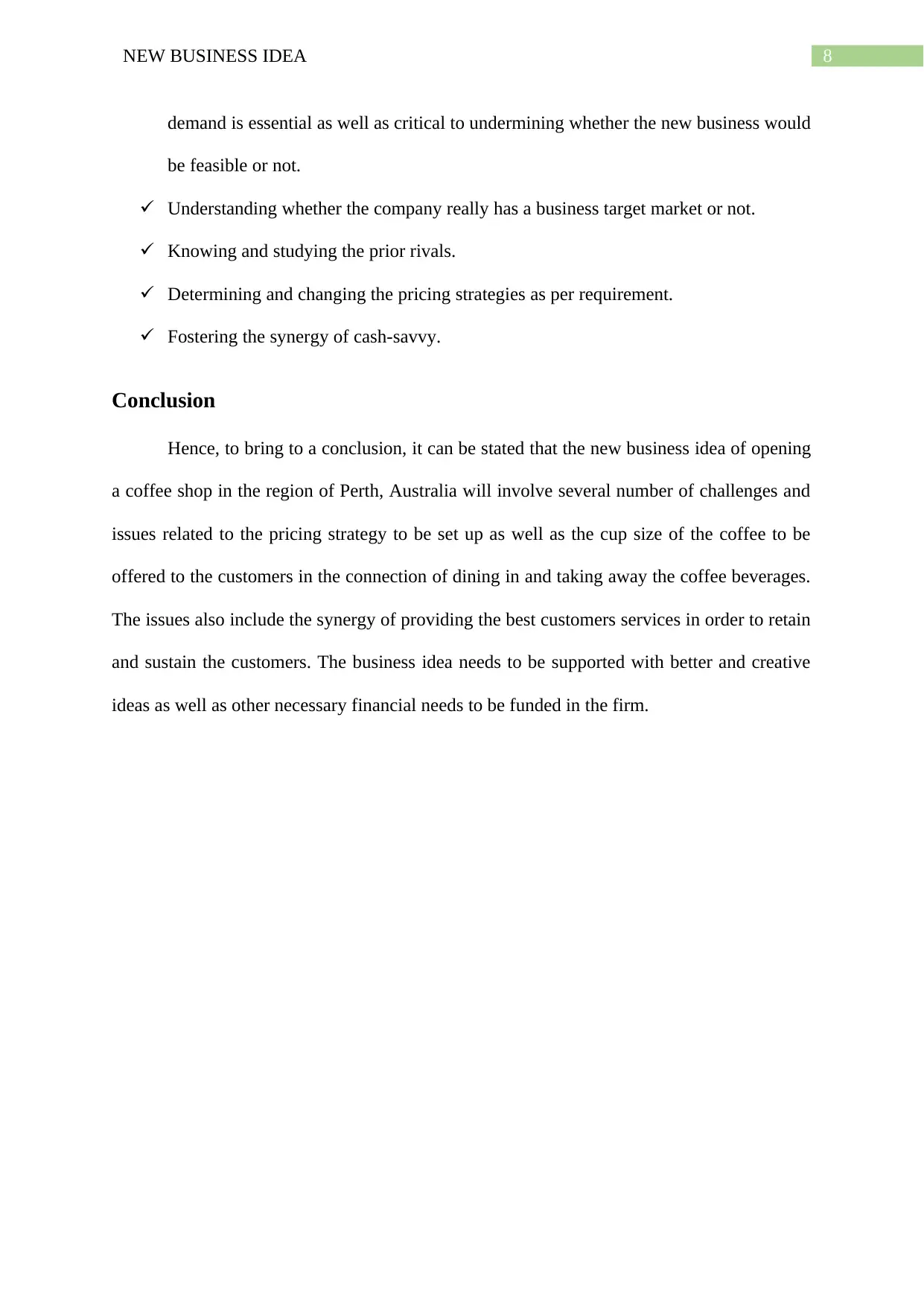
8NEW BUSINESS IDEA
demand is essential as well as critical to undermining whether the new business would
be feasible or not.
Understanding whether the company really has a business target market or not.
Knowing and studying the prior rivals.
Determining and changing the pricing strategies as per requirement.
Fostering the synergy of cash-savvy.
Conclusion
Hence, to bring to a conclusion, it can be stated that the new business idea of opening
a coffee shop in the region of Perth, Australia will involve several number of challenges and
issues related to the pricing strategy to be set up as well as the cup size of the coffee to be
offered to the customers in the connection of dining in and taking away the coffee beverages.
The issues also include the synergy of providing the best customers services in order to retain
and sustain the customers. The business idea needs to be supported with better and creative
ideas as well as other necessary financial needs to be funded in the firm.
demand is essential as well as critical to undermining whether the new business would
be feasible or not.
Understanding whether the company really has a business target market or not.
Knowing and studying the prior rivals.
Determining and changing the pricing strategies as per requirement.
Fostering the synergy of cash-savvy.
Conclusion
Hence, to bring to a conclusion, it can be stated that the new business idea of opening
a coffee shop in the region of Perth, Australia will involve several number of challenges and
issues related to the pricing strategy to be set up as well as the cup size of the coffee to be
offered to the customers in the connection of dining in and taking away the coffee beverages.
The issues also include the synergy of providing the best customers services in order to retain
and sustain the customers. The business idea needs to be supported with better and creative
ideas as well as other necessary financial needs to be funded in the firm.
⊘ This is a preview!⊘
Do you want full access?
Subscribe today to unlock all pages.

Trusted by 1+ million students worldwide
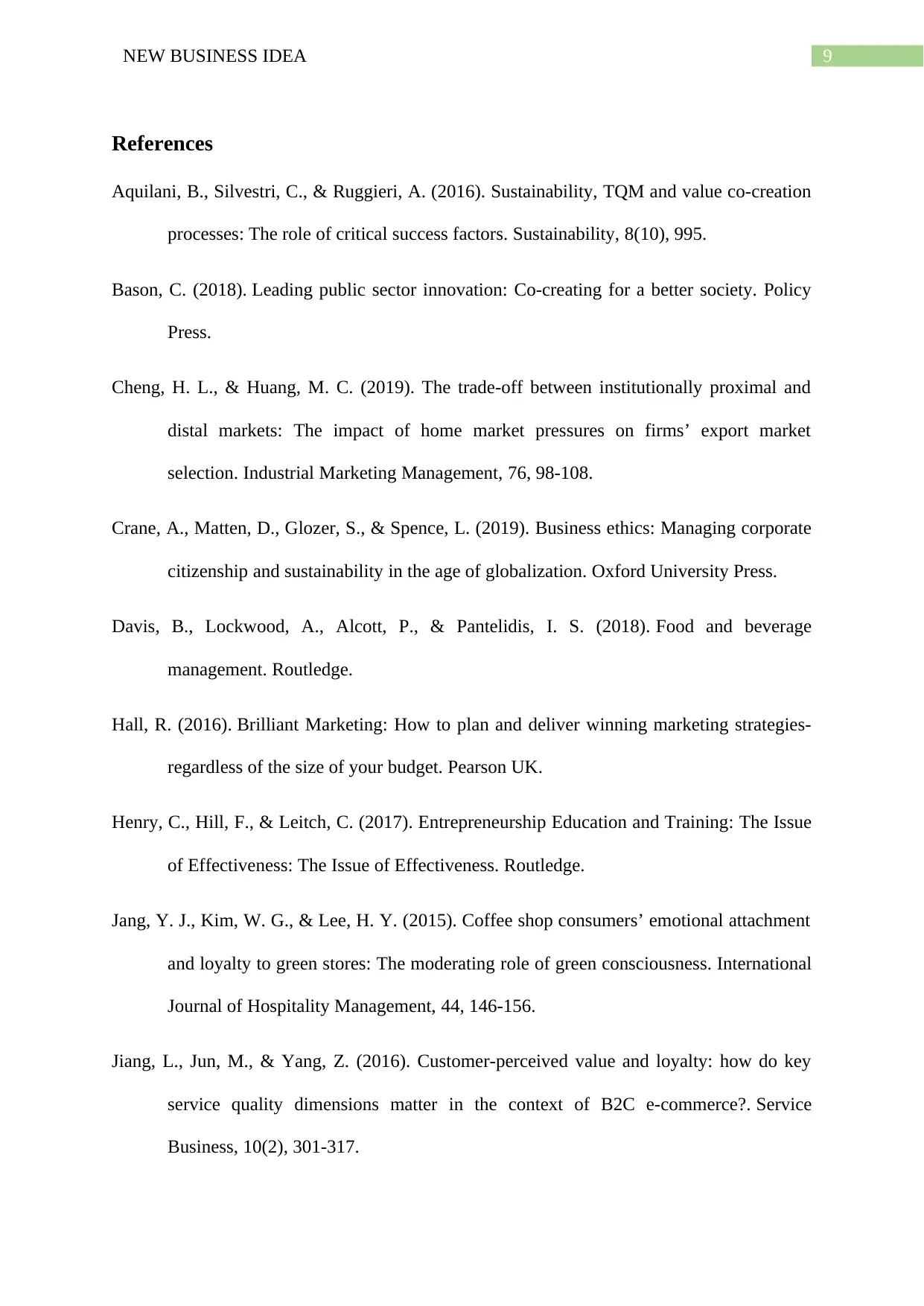
9NEW BUSINESS IDEA
References
Aquilani, B., Silvestri, C., & Ruggieri, A. (2016). Sustainability, TQM and value co-creation
processes: The role of critical success factors. Sustainability, 8(10), 995.
Bason, C. (2018). Leading public sector innovation: Co-creating for a better society. Policy
Press.
Cheng, H. L., & Huang, M. C. (2019). The trade-off between institutionally proximal and
distal markets: The impact of home market pressures on firms’ export market
selection. Industrial Marketing Management, 76, 98-108.
Crane, A., Matten, D., Glozer, S., & Spence, L. (2019). Business ethics: Managing corporate
citizenship and sustainability in the age of globalization. Oxford University Press.
Davis, B., Lockwood, A., Alcott, P., & Pantelidis, I. S. (2018). Food and beverage
management. Routledge.
Hall, R. (2016). Brilliant Marketing: How to plan and deliver winning marketing strategies-
regardless of the size of your budget. Pearson UK.
Henry, C., Hill, F., & Leitch, C. (2017). Entrepreneurship Education and Training: The Issue
of Effectiveness: The Issue of Effectiveness. Routledge.
Jang, Y. J., Kim, W. G., & Lee, H. Y. (2015). Coffee shop consumers’ emotional attachment
and loyalty to green stores: The moderating role of green consciousness. International
Journal of Hospitality Management, 44, 146-156.
Jiang, L., Jun, M., & Yang, Z. (2016). Customer-perceived value and loyalty: how do key
service quality dimensions matter in the context of B2C e-commerce?. Service
Business, 10(2), 301-317.
References
Aquilani, B., Silvestri, C., & Ruggieri, A. (2016). Sustainability, TQM and value co-creation
processes: The role of critical success factors. Sustainability, 8(10), 995.
Bason, C. (2018). Leading public sector innovation: Co-creating for a better society. Policy
Press.
Cheng, H. L., & Huang, M. C. (2019). The trade-off between institutionally proximal and
distal markets: The impact of home market pressures on firms’ export market
selection. Industrial Marketing Management, 76, 98-108.
Crane, A., Matten, D., Glozer, S., & Spence, L. (2019). Business ethics: Managing corporate
citizenship and sustainability in the age of globalization. Oxford University Press.
Davis, B., Lockwood, A., Alcott, P., & Pantelidis, I. S. (2018). Food and beverage
management. Routledge.
Hall, R. (2016). Brilliant Marketing: How to plan and deliver winning marketing strategies-
regardless of the size of your budget. Pearson UK.
Henry, C., Hill, F., & Leitch, C. (2017). Entrepreneurship Education and Training: The Issue
of Effectiveness: The Issue of Effectiveness. Routledge.
Jang, Y. J., Kim, W. G., & Lee, H. Y. (2015). Coffee shop consumers’ emotional attachment
and loyalty to green stores: The moderating role of green consciousness. International
Journal of Hospitality Management, 44, 146-156.
Jiang, L., Jun, M., & Yang, Z. (2016). Customer-perceived value and loyalty: how do key
service quality dimensions matter in the context of B2C e-commerce?. Service
Business, 10(2), 301-317.
Paraphrase This Document
Need a fresh take? Get an instant paraphrase of this document with our AI Paraphraser

10NEW BUSINESS IDEA
Kogan, L., Papanikolaou, D., Seru, A., & Stoffman, N. (2017). Technological innovation,
resource allocation, and growth. The Quarterly Journal of Economics, 132(2), 665-
712.
Korteweg, A., & Nagel, S. (2016). Risk‐adjusting the returns to venture capital. The Journal
of Finance, 71(3), 1437-1470.
Liedtka, J. (2015). Perspective: Linking design thinking with innovation outcomes through
cognitive bias reduction. Journal of Product Innovation Management, 32(6), 925-938.
Manoharan, S., & Alexander, P. (2018). Optimisation of supply chain management in
Spotless Catering.
Osterwalder, A., & Pigneur, Y. (2010). Business model generation: a handbook for
visionaries, game-changers, and challengers. John Wiley & Sons.
Ryan, D. (2016). Understanding digital marketing: marketing strategies for engaging the
digital generation. Kogan Page Publishers.
Spreitzer, G. M., Cameron, L., & Garrett, L. (2017). Alternative work arrangements: Two
images of the new world of work. Annual Review of Organizational Psychology and
Organizational Behavior, 4, 473-499.
Taylor, N., Hurley, U., & Connolly, P. (2016, May). Making community: the wider role of
makerspaces in public life. In Proceedings of the 2016 CHI Conference on Human
Factors in Computing Systems (pp. 1415-1425). ACM.
Trevino, L. K., & Nelson, K. A. (2016). Managing business ethics: Straight talk about how to
do it right. John Wiley & Sons.
Tucker, C. M. (2017). Coffee culture: Local experiences, global connections. Routledge.
Kogan, L., Papanikolaou, D., Seru, A., & Stoffman, N. (2017). Technological innovation,
resource allocation, and growth. The Quarterly Journal of Economics, 132(2), 665-
712.
Korteweg, A., & Nagel, S. (2016). Risk‐adjusting the returns to venture capital. The Journal
of Finance, 71(3), 1437-1470.
Liedtka, J. (2015). Perspective: Linking design thinking with innovation outcomes through
cognitive bias reduction. Journal of Product Innovation Management, 32(6), 925-938.
Manoharan, S., & Alexander, P. (2018). Optimisation of supply chain management in
Spotless Catering.
Osterwalder, A., & Pigneur, Y. (2010). Business model generation: a handbook for
visionaries, game-changers, and challengers. John Wiley & Sons.
Ryan, D. (2016). Understanding digital marketing: marketing strategies for engaging the
digital generation. Kogan Page Publishers.
Spreitzer, G. M., Cameron, L., & Garrett, L. (2017). Alternative work arrangements: Two
images of the new world of work. Annual Review of Organizational Psychology and
Organizational Behavior, 4, 473-499.
Taylor, N., Hurley, U., & Connolly, P. (2016, May). Making community: the wider role of
makerspaces in public life. In Proceedings of the 2016 CHI Conference on Human
Factors in Computing Systems (pp. 1415-1425). ACM.
Trevino, L. K., & Nelson, K. A. (2016). Managing business ethics: Straight talk about how to
do it right. John Wiley & Sons.
Tucker, C. M. (2017). Coffee culture: Local experiences, global connections. Routledge.

11NEW BUSINESS IDEA
Wheeler, A. (2017). Designing brand identity: an essential guide for the whole branding
team. John Wiley & Sons.
Wheeler, A. (2017). Designing brand identity: an essential guide for the whole branding
team. John Wiley & Sons.
⊘ This is a preview!⊘
Do you want full access?
Subscribe today to unlock all pages.

Trusted by 1+ million students worldwide
1 out of 14
Related Documents
Your All-in-One AI-Powered Toolkit for Academic Success.
+13062052269
info@desklib.com
Available 24*7 on WhatsApp / Email
![[object Object]](/_next/static/media/star-bottom.7253800d.svg)
Unlock your academic potential
Copyright © 2020–2025 A2Z Services. All Rights Reserved. Developed and managed by ZUCOL.





